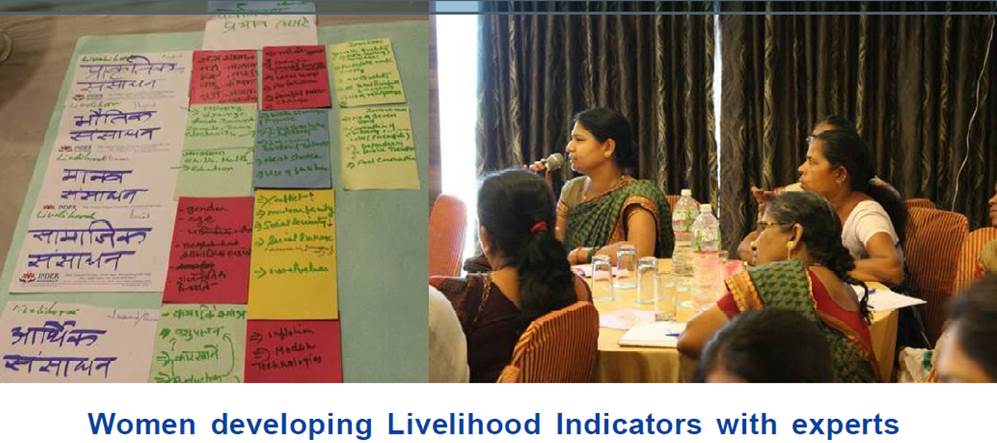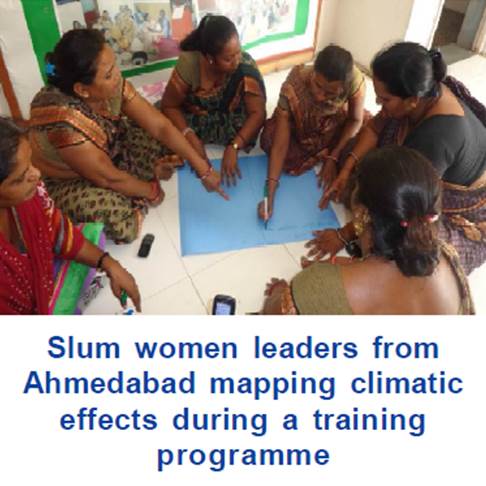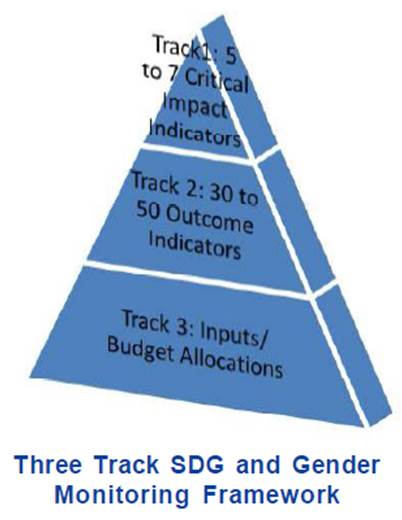Tracking Women’s Empowerment
in SDG Implementation
T
he Sustainable Development Goals (SDGs) have charted out a universal holistic framework to help set the world on a path towards sustainable development by addressing economic development, social inclusion, environmental sustainability and good governance. Women’s empowerment is expected to be a pre-condition for this, with goals and targets specifically recognising women’s equality and empowerment, both as an objective and as a solution.It is well recognised that this would mean moving beyond the stand-alone gender goal 5 –‘Achieve gender equality and empower all women and girls’. Several targets in the other SDGs also address gender equality and the empowerment of women and girls. Therefore, it is important to take a holistic view of gender equality throughout the entire framework and ensure that concerns that are not addressed in SDG 5 are addressed in the other goals.
To address this, gender activists have been advocating for ensuring inclusion of appropriate gender indicators and a thorough and effective monitoring of progress on gender equality across all goals. UN Women (2015) has already identified a set of 48 indicators for which sex-disaggregated data needs to be collected.
1 If achieved, this would be a mammoth task and would change the way gender issues are analysed, addressed and progress monitored globally. There are, however, reservations regarding its doability.
 First
let us turn to the tracking of the SDGs themselves. They pose a number of
challenges, two of which have been discussed here. As stressed by many, the
choice of indicators to monitor the implementation of the current framework
is of critical importance. This will to a large extent determine whether
policy efforts are channelled adequately and the goals and targets are
achieved properly. However, this has resulted in there being more than 169
targets
First
let us turn to the tracking of the SDGs themselves. They pose a number of
challenges, two of which have been discussed here. As stressed by many, the
choice of indicators to monitor the implementation of the current framework
is of critical importance. This will to a large extent determine whether
policy efforts are channelled adequately and the goals and targets are
achieved properly. However, this has resulted in there being more than 169
targets

The other is that sustainable development challenges, by implication, highlight the need for constant learning and adaptation. This means evaluative thinking must be embedded into the planning and budgeting processes rather than focus only on reporting. The target based approach could lead to countries focusing the energies of the statistical systems on data gathering rather than on developing mechanisms to test response strategies and use feedback to make necessary changes.
Given the complexities, the tracking of SDGs itself needs to be reoriented to move beyond only indicators to create systems which apart from capturing results at a broader level, also include tracking of inputs in the form of fund flow as well as the resulting outputs, which should ideally feed into the country’s own development agenda and areas of investment.
India, for example has already emphasised that many of the SDGs – which form the core of the 2030 Agenda for Sustainable Development – are already being implemented through flagship programmes of the government such as Swachh Bharat Abhiyaan (for better sanitation), Make in India, Digital India, Skill India, Smart Cities and Jan Dhan Yojana (banking the unbanked).4 With this approach, it would actually be good to target the evaluation systems to assess the validity of the cause-effect relationships between these programmes and the achievement of the SDG targets. Well planned, independent evaluations, not depending on the Central Statistical Organisation, but by expert academics can assess how effectively these relationships work and provide feedback to the overall implementation process by taking a dispassionate look at results and performance.
It is in this context that, we would like to place the monitoring of the women’s empowerment indicators. Lancet (2015) has already suggested a two track approach to the indicator framework which would consist of a limited set of high level political ‘umbrella’ indicators as well as more detailed technical indicators that can capture the breadth of the new agenda. A modified three track SDG and Gender Monitoring framework similar to the Lancet model is being suggested for tracking the gender commitments of the SDGs. The process required for the same could be:
• Identify 5 to 7 critical gender impact indicators in line with the reporting requirements of the SDGs for Gender Equality and Empowerment.
• All Ministries/Departments
to establish a list of their programmes/schemes which can contribute
directly or indirectly to the above indicators and rank them on a five point
scale for gender inclusiveness targeting.

• Determine the cause-effect relationship between the government programmes which score high on gender inclusiveness and would have a higher impact on achieving these indicators.
• Identify a list of most critical programmes/schemes which can contribute to gender equality and empowerment.
• Develop a list of around 30 to 50 sub-indicators for mapping the desired gender outcomes of these selected programmes.
• Establish systems for tracking these outcome indicators on an annual basis. (If an indicator shows poor performance, it should highlight the need for change in programme design).
• Monitor the gender commitments of the government towards the goal of women’s empowerment by tracking budget allocations in these schemes, especially reviewing its adequacy, appropriateness and utilisation.
This would need to be a one-time extensive exercise with gender experts on board, but would also go a long way in establishing the gender inclusiveness of each of the government line ministries. As mentioned earlier, smaller independent evaluations can be conducted at regular intervals to establish and review the cause and effect relationship, which would provide validity to the tracking process. Also the establishment of gender outcome indicators for programmes which have a high potential to impact the progress and review of the same would provide an effective feedback loop based on real time data for making timely changes in programme design.
This model could build on the existing gender budgeting mechanism being put in place by the Ministry of Finance and Ministry of Women and Child Development, Government of India. There are already existing institutional mechanisms in place, which can be strengthened with this additional focus on looking at SDG targets and gender equality.
Further, by linking investment to gender outcomes, the annual monitoring would be actually tracking of budgetary allocations and expenditures rather than collating the data on outcomes and impacts which are less likely to change at an annual level. At the same time, we can focus on collection of data on specific gender indicators at an annual level, which not only help reporting on the SDGs, but also enable us as a country to reflect on the growth of women’s equality and empowerment agenda in India.
The suggested tracking of SDG and gender monitoring framework would establish a close alignment of the key gender developmental priorities of India with the global sustainable development agenda and an establishment of relatively simpler monitoring mechanisms for tracking progress, while focusing the energies of national statistical agencies on gathering the much critical impact data. q
Dharmistha Chauhan
Strategic Advisor,
Mahila Housing Trust
dharmisthac@gmail.com
Endnotes
1 un women, september 2015, position paper on monitoring gender equality and the empowerment of women and girls in the 2030 agenda for sustainable development: opportunities and challenges2 the open working group (owg) proposal
3 http://in.one.un.org/img/uploads/SDGs_PressRelease_September_2015.pdf
4 indian prime minister’s address to the un general assembly